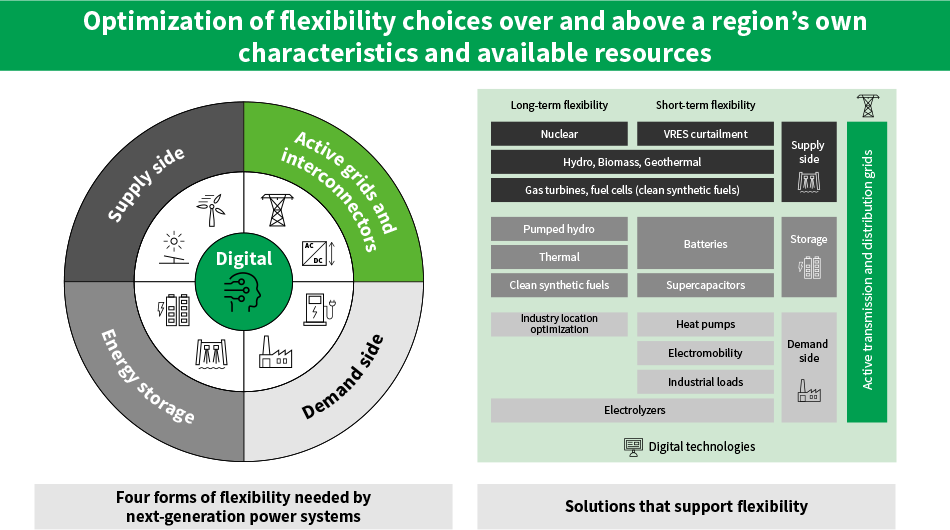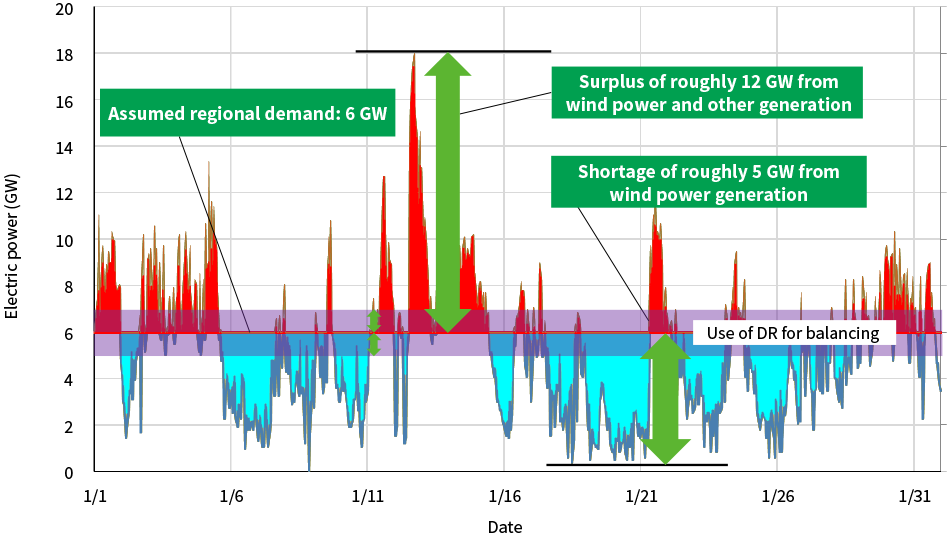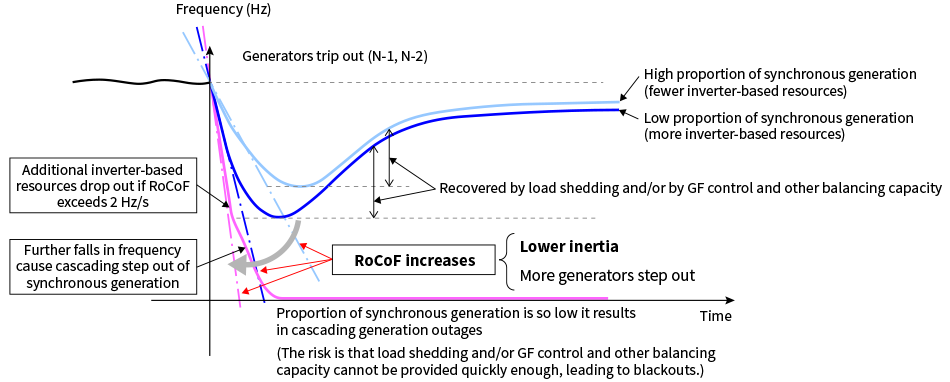Future Grid Initiatives for Achieving Carbon Neutrality in Japan by 2050
Highlight
Efforts to achieve carbon neutrality play an important part in protecting Japan’s growth industries and maintaining its security of energy supply. Given that electricity demand in Japan is expected to increase in response to electrification and the rapid growth in power use by data centers and other such industries, the challenges to achieving carbon neutrality will include not only demand-side measures, but also the development of carbon-neutral electricity generation in various forms, renewables and nuclear power among them.
Among the effective means for achieving carbon neutrality under this environment will be to integrate more renewable energy that has a higher technology readiness level (TRL) and to build the intra-regional grids and cross-regional interconnection lines (hybrid grids) needed to maximize utilization of those renewables.
This article reviews global trends in how electricity grids are adapting to the carbon neutrality transition, also discussing background considerations that include enhancing the flexibility of the electric power system and technological measures for addressing the problem of low inertia when grids introduce a large amount of renewable energy.
1. Introduction
Global warming prevention measures are an urgent priority to protect the global environment for future generations. The solution to this challenge lies in making the transition to carbon neutrality. Efforts to achieve this should serve as an engine for future growth while also helping to alleviate rapidly rising geopolitical risks.
The main reasons why Japan should pursue carbon neutrality are as follows.
- Action on preventing global warming
Humanity has a responsibility to all the different forms of life on Earth to prevent damage to the environment or maintain it in its current state, and to minimize global warming by reducing the amount of greenhouse gases emitted by human activity. As members of international society, Japan and its people need to act to build a sustainable society.
Japan published its 2050 Carbon Neutral Declaration in October 2020. The Strategic Energy Plan of October 2021 set a target of increasing renewable generation capacity by more than 130 TWh (equating to 66 GW of solar and wind generation capacity) between 2020 and 2030 and the Cross-Regional Network Development Master Plan of the Organization for Cross-regional Coordination of Transmission Operators, Japan (OCCTO) formulated in March 2023 was based on the assumption that satisfying electricity demand in 2050 (1,200 TWh) would require additional renewable energy capacity in the form of 260 GW of solar and 89 GW of wind generation1), 2).
As described below, it is anticipated that wider use of artificial intelligence (AI) will increase future demand for electricity in Japan and that even more renewable energy generation will be needed if this is to be supplied from zero-carbon sources.
- Engine for future growth
Carbon neutrality also needs to be achieved in economic activities and is a critical issue for Japan’s industries. Economic growth will require investment in carbon-neutral energy generation. Those industrial products that do not contribute to carbon neutrality will be shunned by the market and this could lead to a foundering Japanese economy with a hollowing out of industry as factories and talent move overseas. What is needed, then, is to foster industries that are in step with the transition to carbon neutrality in the domestic market and have them expand internationally.
One example is how the world’s leading companies, including the GAFAM quintet of Google, Amazon, Facebook, Apple, and Microsoft, are taking steps to stop purchasing products manufactured using non-carbon-neutral energy. Apple has set a target of achieving carbon neutrality in its supply chains and across its product life cycles by 2030, using its own criteria to make annual assessments of progress on decarbonization by its major partners. As it is anticipated that these carbon-neutral procurement practices will expand beyond the GAFAM companies, investment in renewable energy should be seen as the initial investment for Japanese industrial development.
- Geopolitical risk
Being a nation that relies on imports for the bulk of its energy resources leaves Japan exposed to geopolitical risks, so there is a need to raise the level of energy self-sufficiency and to pursue security of supply. In addition to the use of nuclear power for base-load generation, this too demands action on achieving carbon neutrality through the widespread development of renewable energy.
2. Scenarios Needed for Japan to Achieve Carbon Neutrality
A survey of demand for both Japan as a whole and for individual supply regions issued by OCCTO in January 2024 predicted that demand for electric power would resume a rising trend from FY2024 onwards3). At an open forum held in March 2024 by the Hitachi-UTokyo Laboratory, a prediction was given that electricity demand in Japan would rise from about 1,000 TWh in FY2020 to 1,800 TWh in 20504). In addition to ongoing progress on electrification in industry and logistics, rising demand from data centers will also be a major factor, driven by the growing role of information technology in society and growth in the volume of information processing for AI and other applications.
To raise the level of energy self-sufficiency and to pursue security of supply in an environment of rising electricity demand will require the adoption of a wide variety of solutions for achieving net zero by absorbing greenhouse gases while also reducing energy consumption and the volume of CO2 emissions per unit of output. These solutions will include the development of carbon-neutral methods of electricity generation such as renewable energy, nuclear power, and generation from hydrogen or ammonia; electrical storage; a transition to other forms of energy such as hydrogen; electrification; carbon dioxide capture, utilization and storage (CCUS); energy efficiency; and the use of industry zoning to encourage local consumption of locally produced energy.
In practice, this will involve a combination of, (1) energy savings and higher energy efficiency, (2) the decarbonization of electricity production, defined as reducing CO2 emissions per unit output in the electricity sector to zero, (3) the electrification of industries other than electric power, and (4) negative emissions.
In particular, achieving carbon neutrality will require doing so in the major urban areas that account for around 80% of electricity demand. Unfortunately, this will be difficult to achieve by relying solely on energy-efficiency measures and the development of renewable energy generation in large cities, on encouraging demand for renewable energy generation by relocating industry close to generation sites, and on the use of workload shifting between data centers. Rather, grid upgrades will be needed to facilitate the development of generation at sites that suit renewables and the transmission of this electric power to major urban areas.
3. Grid Initiatives Needed for Carbon Neutrality in Japan and Role of Cross-regional Grids
Given that renewables need to become a major source of electricity generation, distributing this power widely across Japan together with the electricity from decarbonized thermal and nuclear power generation will require that Japan first establish hybrid grids that strengthen both the intra-regional power systems and cross-regional interconnection lines that allow for the development of renewable energy. Doing so will enable a large-scale build-out of renewable energy with a higher TRL.
The intra-regional power systems that support the activities of people and of wider society, including the industrial and consumer sectors, obtain their supply of energy by means of cross-regional interconnection lines. It is anticipated that these local grids will play a central role in achieving carbon neutrality by using digital and other technologies for measures such as time shifting that balance the supply and demand.
Considerable investment into cross-regional interconnection lines is taking place around the world in anticipation of a large-scale build-out of wind power generation. In Japan, however, little progress has been made on offshore wind development due to the lack of cross-regional grids linking locations with plentiful offshore wind resources, such as Hokkaido, Tohoku, and Kyushu, with the major centers of demand.
Countries such as the UK and Germany are putting in the upfront investment in infrastructure for delivering clean energy to where it is needed that will encourage investment in large-scale wind power generation. Likewise in Japan, measures to encourage offshore wind and other renewable energy development through upfront investment in a number of cross-regional interconnection lines schemes are being expedited to allow the development of 15 GW or more of offshore wind potential in places like Hokkaido. The availability of this energy will facilitate the transition to carbon neutrality in those places where a large demand center is located.
4. Why Progress is Happening Overseas on Renewable Energy and Grids and the Relevant Technologies
4.1 Global Developments in Electricity Grids
Around the world, especially in Europe, building of transmission lines to realize carbon neutrality target is gaining speed. (see Figure 1)5).
The reasons for this include, (1) national and regional decarbonization will require the sharing of carbon-neutral energy among regions, (2) renewables such as wind and solar, together with grids have a higher TRL and quick effectiveness for decarbonization, and (3) new technologies such as the grid stabilization scheme by high-voltage direct current (HVDC), etc. 6) are helping to improve controllability, thereby meeting the need for stabilization on increasingly complex grids.
Figure 1—Progress on HVDC Deployment in Europe HVDC: high-voltage direct currentGrids in Europe and around the world are expanding at an accelerating pace for the cross-regional sharing of carbon-neutral energy and grid flexibility. The number of projects, both under construction and undergoing planning, is increasing rapidly.
HVDC: high-voltage direct currentGrids in Europe and around the world are expanding at an accelerating pace for the cross-regional sharing of carbon-neutral energy and grid flexibility. The number of projects, both under construction and undergoing planning, is increasing rapidly.
4.2 Improving Power System Flexibility and Role of Cross-regional Interconnection Lines
Achieving carbon neutrality will require greater power system flexibility in the four areas of supply side, demand side, energy storage, and active grids (see Figure 2).
Figure 2—Four Forms of Flexibility Needed for Next-generation Power Systems Achieving carbon neutrality calls for greater grid flexibility to manage fluctuations in generation and maintain stability. This will require choosing the right combination and balance of solutions, in accordance with the regional characteristics and available resources.
Achieving carbon neutrality calls for greater grid flexibility to manage fluctuations in generation and maintain stability. This will require choosing the right combination and balance of solutions, in accordance with the regional characteristics and available resources.
As noted above, demand-side measures will be important for achieving carbon neutrality nationwide, with encouragement for the optimization of siting of industries and storage, demand response (DR) measures such as batteries and workload shifting among data centers, and the use of pumped hydro and other tools for improving flexibility. However, these alone would not be sufficient to the task of balancing supply and demand on a gigawatt scale. Considerations of practicality and economics mean that cross-regional interconnection lines will also have an important part to play. Transmission links from renewable-rich locations will also be needed for the major centers of demand to achieve carbon neutrality.
Figure 3 shows a graph of how the balance between supply and demand might fluctuate over a period of a month assuming 18 GW of installed wind capacity against 6 GW of demand, and the wind conditions found in those parts of Japan with superior offshore wind potential. As the red line represents the 6 GW of demand, regions above and below this line indicate over- and under-supply, respectively. During times of over-supply, in addition to the increase in demand by DR (including workload shifting among data centers) as shown in the graph, there is also a need for charging batteries, hydrogen production, pumping up by pumped hydro, output curtailment, and transmitting power to other regions to balance the supply and demand. In contrast, times of under-supply require the use of DR to reduce demand, bringing in power from other regions, and supply from other sources such as battery discharge, generation from pumped hydro, and other forms of generation.
At the present level of technology, the transmission of electricity over cross-regional interconnection lines is the most practical and economical way to balance supply and demand on a multi-gigawatt scale. Failure to build the transmission links needed for this could result in extensive curtailment of wind power output, inhibiting investment toward renewables. If this investment in renewable energy generation does not proceed, it will also lead to the failure of measures to encourage industries to come to the optimal locations. This is because investment in the construction of factories and other facilities that require a reliable supply of clean electric power will likewise fail to eventuate. In a world that is pushing ahead with getting grid infrastructure in place, it pays to remember that encouraging private-sector investment in renewable generation is also a factor to consider.
Figure 3—Comparison of Variability in Wind Power Generation Due to Wind Conditions and Capacity for DR to Adjust Demand DR: demand responseThere are times when the power available from favorable offshore generation sites is significantly out of step with demand. Moreover, the adjustment capacity that DR can realistically and economically provide is unlikely to be enough to deal with the swings in renewable generation. If more renewable generation is added in the future, cross-regional interconnection lines will be important for balancing supply and demand in addition to local demand-side measures.
DR: demand responseThere are times when the power available from favorable offshore generation sites is significantly out of step with demand. Moreover, the adjustment capacity that DR can realistically and economically provide is unlikely to be enough to deal with the swings in renewable generation. If more renewable generation is added in the future, cross-regional interconnection lines will be important for balancing supply and demand in addition to local demand-side measures.
4.3 Dealing with Low Inertia on Grids with Large Renewable Penetration
In addition to the issue discussed above, another concern when the percentage of variable renewable energy (VRE) on the grid rises is that it will lead to cascading generation step-outs, leading to blackouts. This is because more VRE reduces grid inertia and this increases the rate of change of frequency (RoCoF) during grid disturbances (see Figure 4)7). The main response to this being discussed in Japan is the use of rotating machines, either through the retention of synchronous machines (mainly fossil power generation) or the installation of synchronous condensers. On the other hand, increasing use is being made of mechanisms for “synthetic inertia” based on renewable energy or energy storage infrastructure in places like Australia and Europe, such as the UK. As synthetic inertia is much more effective than synchronous machines at frequency stabilization, the grid stabilization benefits of battery storage systems or static synchronous compensators (STATCOMs) with inertia response capabilities and the synthetic inertia and Fast Frequency Response (FFR) capabilities of HVDC, etc. warrant further investigation.
Figure 4—Main Technical Issues with Reducing Presence of Synchronous Generation in Japan Source: Document No. 3 at 57th meeting of the OCCTO Committee on Balancing Capacity and Evaluation of Supply and Demand Balance
Source: Document No. 3 at 57th meeting of the OCCTO Committee on Balancing Capacity and Evaluation of Supply and Demand Balance
GF: governor-free control
RoCoF: rate of change of frequency Increasing the percentage of VRE on the grid has the potential to result in cascading generation outages because it reduces grid inertia and increases the RoCoF during grid disturbances.
To study their ability to perform grid stabilization, the performance of a 100-MVA synchronous condenser (inertia constant H=1.8 s, inertial energy = 180 MWs) and a 100-MVA STATCOM with inertia response capabilities (with 2 s of storage at 100 MW) was compared in terms of how much inertial energy they could provide to the grid prior to trip-out in a grid disturbance where the frequency falls from 50 Hz to 48 Hz. The speed of the synchronous machine falls as it releases inertial energy together with other rotating machines. As the amount of inertial energy supplied to the grid in the process of slowing to 48 Hz is proportional to the square of the frequency, this is 7.8% of 180 MWs [(1-(48⁄50)2 )=0.078], namely 14.1 MWs. An inertial response by STATCOM with the same capacity, on the other hand, can deliver 100 MW × 2 s = 200 MWs, which is to say 15 times the inertial energy provided by the 100-MVA synchronous condenser.
While this is just one example, it is important that the discussion about how to cope with the transition to having a high proportion of renewable energy be kept up to date with the latest technologies and knowledge from overseas.
5. Conclusions
This article has looked at how best to go about offshore wind power development and the upgrading of grid infrastructure under a carbon-neutral scenario primarily in terms of the technical considerations. However, realizing carbon neutrality will also require the establishment of a regulatory environment that encourages the development of offshore wind and other forms of renewable energy generation. Looking at what is happening overseas in countries like Germany that are investing in offshore wind generation, the investments in access links for connecting that generation to the onshore grid is being paid for not out of the wind generation revenue, but from fixed fees or other similar mechanisms that are independent of generation output.
As Japan, in contrast, does fund investment access links out of wind generation revenue, longer access links and higher costs diminish project profitability. This is why development has been limited to small projects at locations that are easy to connect to the grid, with a failure to proceed on large-scale projects at locations where the wind conditions make for efficient investment. To make use of the wind resources with potential for offshore wind power development that exist in Japan’s exclusive economic zone (EEZ), the government should provide the access links that connect offshore wind generation to the onshore grid and make them available to the generation operators as shared infrastructure.
The technology of electric power systems is going through major advances in the transition to decarbonization and greater use of renewable energy offshore. Given these technology trends, it is important, not least for Japan’s international competitiveness, that the nation avoid the “Galapagos trap” of evolving independently of international practice in its transition to carbon neutrality. In order to protect Japan’s growth industries and maintain its security of energy supply, it is hoped that a debate about how best to move to the hybrid grids needed for carbon neutrality will lead to accelerated grid investment.
REFERENCES
- 1)
- Ministry of Economy, Trade and Industry, Outlook for Energy Supply and Demand in FY2030 (Reference Material) (Oct. 2021) in Japanese.
- 2)
- Organization for Cross-regional Coordination of Transmission Operators, Japan, Long-term Vision of Cross-regional Network Development (Master Plan for Cross-regional Grids) (Mar. 2023) in Japanese.
- 3)
- Organization for Cross-regional Coordination of Transmission Operators, Japan, Outlook of Electricity Supply-Demand and Cross-regional Interconnection Lines (FY2024) (Jan. 2024) in Japanese.
- 4)
- H-UTokyo Lab., Toward Realizing Energy Systems to Support Society 5.0 (June 2024)
- 5)
- TenneT Offshore
- 6)
- Hitachi Energy, High-Voltage Direct Current (HVDC)
- 7)
- Organization for Cross-regional Coordination of Transmission Operators, Japan, Document No. 3 at 57th meeting of the Committee on Balancing Capacity and Evaluation of Supply and Demand Balance, Review of work on technical issues facing the transition to renewable generation and measures for dealing with them. (Feb.2021) in Japanese.



